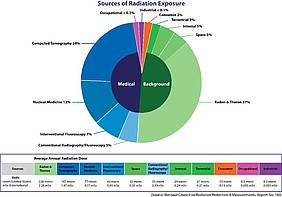Hint: iQ-DOSE – How to identify a reportable radiation dose excess or an excess requiring immediate action
According to the U.S. National Council on Radiation Protection, an average of about 48% of the human radiation exposure comes from radiology imaging.
However, this number may strongly differ depending on the medical devices used or where a person lives. For instance, older CT scanners emit higher doses than newer ones and the natural radon exposure is usually much higher in mountain areas than it is in regions close to the sea.
So how can an operator find out whether the dose exposure is just right, still acceptable or too high?
When iQ-DOSE receives DICOM data from the connected PACS, it looks for radiation dose information like volumetric doses or the dose area product and compares it with state-of-the-art values. Which values apply and when exceeding these values may require a notification to the authorities, depend on the country-specific regulations and established dose limits. Therefore, iQ-DOSE allows the healthcare institutions to specify these limits and reportable doses prior to using the application.
If, for example, the limit of e.g. 80 mGy for an abdominal CT dose index was exceeded, iQ-DOSE will mark the respective study in red color indicating the need for immediate action, such as checking the device protocol and/or reporting the case to the competent authorities:
see picture 2 on the left side
In case a reportable overdose event occurs, iQ-DOSE immediately sends an e-mail to the radiation protection supervisor. The supervisor then logs into iQ-DOSE and checks the case details. As iQ-DOSE seamlessly interfaces with iQ-VIEW, the supervisor can easily review the suspicious case to find out the reason for the overdose (e.g. operator error, protocol error, obesity etc.). This reason should then be documented and reported, if necessary.
